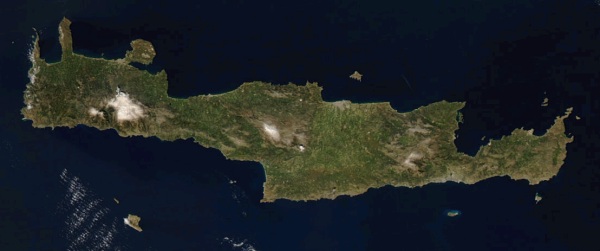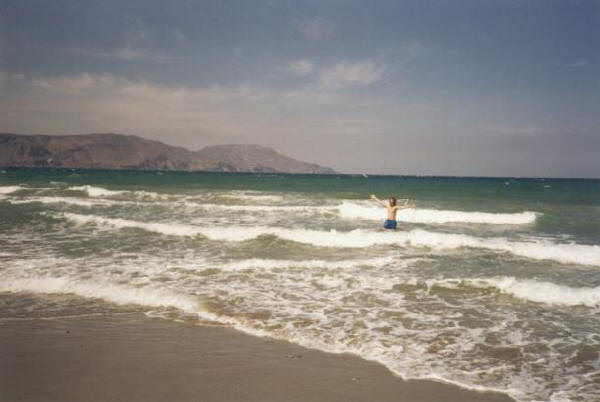|












































| |
About Crete

Satellite image of the island courtesy of NASA http://visibleearth.nasa.gov/

Crete is the largest of the Greek
islands and separates the Aegean Sea from the Mediterranean. At 152 miles from
West to East and a maximum of 35 miles from North to South it is the fifth
largest island in the Med. Contained within a total area of over 3,180 square
miles are around 15,000 villages and settlements. Being the most southerly point
of Europe, lying farther South than Tangiers, the island benefits from short
mild winters and long hot summers.
The main centers of population are on the North coast of the island. From West
to East the major towns are Chania, Rethymnon, Heraklion (capital) and Agios
Nikolaos. The old towns of Chania and Rethymnon exhibit some fine examples of
Venetian architecture.
The landscape consists of craggy coastline, deserted sandy beaches, forested
hills and snow-capped mountains. Mount Ida in the middle of the island rises to
8,105 feet (2,456 metres) whilst the multiple peaks of the White Mountains in
the West are just 3 metres lower. Reaching down from the White Mountains to the
South coast the Samaria Gorge, at ten miles in length, is the longest and most
spectacular gorge in Europe.
With a history of advanced cultures dating back well over 4,000 years, Crete has
been labelled the birthplace of civilization. Between 1900 and 1905 Sir Arthur
Evans excavated the Minoan site of Knossos, a Bronze Age settlement c. 3,000BC.
The well-preserved Palace at Knossos is the finest surviving example of Minoan
architecture. The legendary Minotaur, half man-half bull, was said to inhabit
the labyrinth below the Palace.
The rich culture and history of Crete have given birth to many great artists and
writers. Famous examples include Nikos Kazantzakis, author of 'Zorba the Greek'
and Domenikos Theotokopoulos, more commonly known as 'El Greco', the most
outstanding 16th century painter of the Spanish school.
The rugged countryside continues to inspire artists, painters and photographers
alike. In late January after a relatively short mild winter, spring bursts in to
life with a spectacular display of wild flowers. Red poppies and mustard yellow
flowers carpet the olive groves; on uncultivated ground wild anemone, tulips and
delicate orchids bloom.
Blessed with a rich fertile soil many Cretan families are virtually
self-sufficient. The combined effects of fertile soil and Mediterranean climate
ensure a constant supply of high quality natural tasting fruit and vegetables.
The locals say take care when discarding seeds, pips and stones as everything
grows so well in Crete.
If you have not yet experienced Cretan hospitality you are in for a pleasant
surprise. Relaxed and friendly, Cretans gain great pleasure from the act of
giving.
Published by the
BBC
in May 2000. Tim Rainey © 2000
| |
|